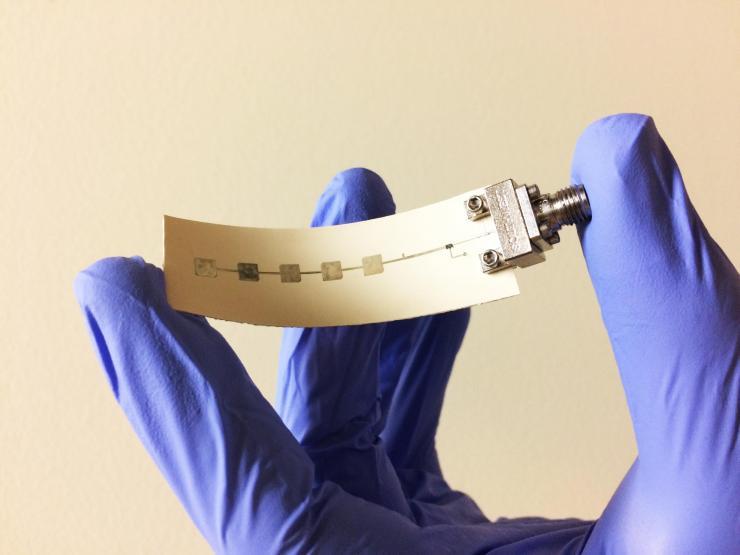
Circuit that reduces power leakage when transmitters are idle could greatly extend battery life.
At this year’s Consumer Electronics Show in Las Vegas, the big theme was the “Internet of things” — the idea that everything in the human environment, from kitchen appliances to industrial equipment, could be equipped with sensors and processors that can exchange data, helping with maintenance and the coordination of tasks.
Realizing that vision, however, requires transmitters that are powerful enough to broadcast to devices dozens of yards away but energy-efficient enough to last for months — or even to harvest energy from heat or mechanical vibrations.
“A key challenge is designing these circuits with extremely low standby power, because most of these devices are just sitting idling, waiting for some event to trigger a communication,” explains Anantha Chandrakasan, the Joseph F. and Nancy P. Keithley Professor in Electrical Engineering at MIT. “When it’s on, you want to be as efficient as possible, and when it’s off, you want to really cut off the off-state power, the leakage power.”
This week, at the Institute of Electrical and Electronics Engineers’ International Solid-State Circuits Conference, Chandrakasan’s group will present a new transmitter design that reduces off-state leakage 100-fold. At the same time, it provides adequate power for Bluetooth transmission, or for the even longer-range 802.15.4 wireless-communication protocol.
“The trick is that we borrow techniques that we use to reduce the leakage power in digital circuits,” Chandrakasan explains. The basic element of a digital circuit is a transistor, in which two electrical leads are connected by a semiconducting material, such as silicon. In their native states, semiconductors are not particularly good conductors. But in a transistor, the semiconductor has a second wire sitting on top of it, which runs perpendicularly to the electrical leads. Sending a positive charge through this wire — known as the gate — draws electrons toward it. The concentration of electrons creates a bridge that current can cross between the leads.
But while semiconductors are not naturally very good conductors, neither are they perfect insulators. Even when no charge is applied to the gate, some current still leaks across the transistor. It’s not much, but over time, it can make a big difference in the battery life of a device that spends most of its time sitting idle.
Read more: Radio chip for the “Internet of things”
The Latest on: Internet of things
[google_news title=”” keyword=”Internet of things” num_posts=”10″ blurb_length=”0″ show_thumb=”left”]
via Google News
The Latest on: Internet of things
- Focus Universal Inc. Announces Board Approval for Spin-Off of Lusher Inc.on April 29, 2024 at 3:13 pm
Chief Executive Officer Desheng Wang stated, "We are excited that our management team received authorization from our Board of Directors to start the spin-off process for Lusher Inc. Lusher Inc. which ...
- Shares of Internet of Things Play Impinj Soar on Strong Earnings and Outlookon April 26, 2024 at 12:17 am
Impinj stock skyrocketed Thursday after the chip provider offered robust guidance and better-than-expected earnings. The company manufactures radio-frequency identification, or RFID, chips for ...
- Internet of Things (IoT) Market to Expand at a Stellar 19.4% CAGR through 2031 | SkyQuest Technologyon April 25, 2024 at 3:45 am
Market will attain a value of USD 1572.37 billion by 2031, with a CAGR of 19.4% over the forecast period (2024-2031). Internet of Things (IoT) refers to the network of connected devices over the ...
- Internet of Things (IoT)on April 24, 2024 at 8:23 pm
Upgrade your lifestyleDigital Trends helps readers keep tabs on the fast-paced world of tech with all the latest news, fun product reviews, insightful editorials, and one-of-a-kind sneak peeks.
- Internet of Things in Healthcare Market to Surge to USD 471.20 Billion by 2031: Industry Analysis, Technologies and Competitorson April 22, 2024 at 8:48 am
Internet of Things in Healthcare Market to Surge to USD 47120 Billion by 2031 Industry Analysis Technologies and Competitors ...
- Internet of Thingson April 21, 2024 at 5:00 pm
Silicon Labs is aiming at battery-free harvested energy applications with xG22E, a family of wireless microcontrollers covering Bluetooth Low Energy, 802.15.4 or proprietary 2.4 GHz links. “As Silicon ...
- Exploring the Digital Frontier: 10 Exciting Ways the Internet of Things Impacts Societyon April 17, 2024 at 7:07 am
In today’s rapidly evolving technological landscape, the Internet of Things (IoT) has emerged as a transformative force, revolutionizing the way we interact with the world around us. From smart homes ...
- Innovative Impact: 10 Ways the Internet of Things Redefines Our Worldon April 17, 2024 at 6:24 am
In today’s rapidly evolving technological landscape, the Internet of Things (IoT) stands out as a groundbreaking phenomenon. With its ability to connect devices and enable seamless communication ...
- The security minefield of the Internet of Thingson April 15, 2024 at 2:24 pm
When IoT devices run on outdated firmware or do not get updated regularly, they become easy targets for cybercriminals.
- What You Should Know About The Internet Of Everythingon April 8, 2024 at 11:41 am
Do it now! As Scott J. Shackelford of the University of Indiana argues in his book The Internet of Things: What everyone needs to know: “We are just at the beginning of governing AI with ...
via Bing News










